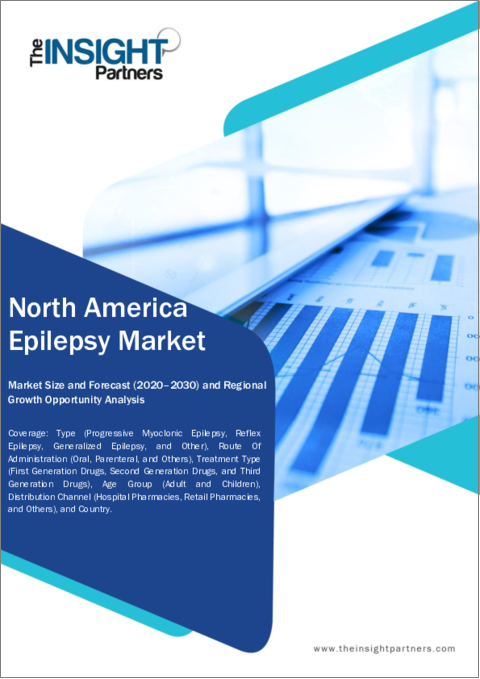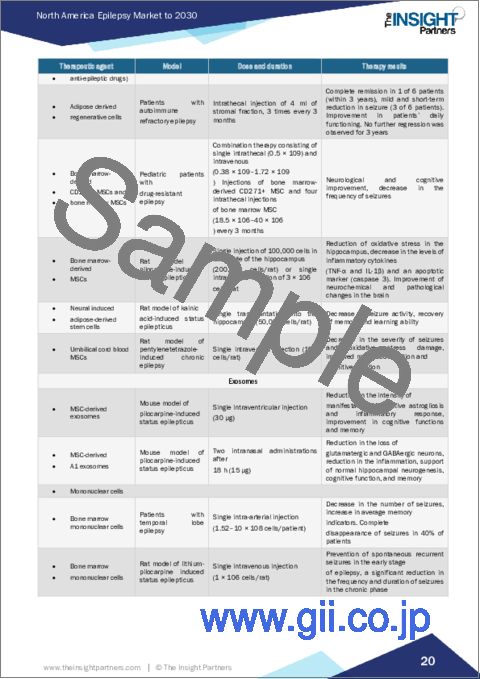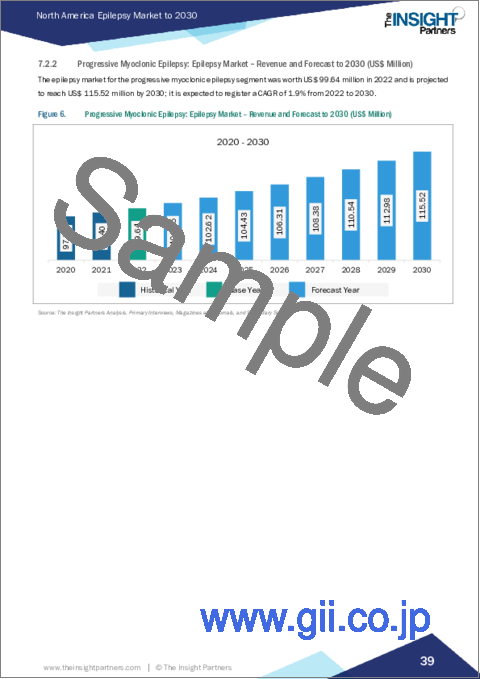|
|
市場調査レポート
商品コード
1592586
北米のてんかん市場:2030年までの予測 - 地域別分析 - タイプ別、投与経路別、治療タイプ別、年齢層別、流通チャネル別North America Epilepsy Market Forecast to 2030 - Regional Analysis - by Type, Route of Administration, Treatment Type, Age Group, and Distribution Channel |
||||||
|
|||||||
| 北米のてんかん市場:2030年までの予測 - 地域別分析 - タイプ別、投与経路別、治療タイプ別、年齢層別、流通チャネル別 |
|
出版日: 2024年09月16日
発行: The Insight Partners
ページ情報: 英文 135 Pages
納期: 即納可能
|
- 全表示
- 概要
- 図表
- 目次
北米のてんかん市場は、2022年に25億7,710万米ドルとなり、2030年までには36億934万米ドルに達すると予測され、2022年から2030年までのCAGRは4.3%と推定されます。
てんかん有病率の上昇が北米のてんかん市場を牽引
てんかんは発作性疾患とも呼ばれ、脳の慢性疾患です。体の一部または全身が不随意に動く短時間の発作を繰り返すのが特徴です。発作は感覚、行動、意識、筋肉の動きを変化させます。てんかんは、遺伝的疾患や、外傷や脳卒中などの後天的な脳損傷によって発症することがあります。世界保健機関(WHO)が2023年2月に発表したデータによると、てんかんは世界の疾病負担の中で大きな割合を占めており、世界中で約5,000万人が罹患しています。さらに、1,000人あたり4人から10人が活動性てんかん(i.e.治療の必要性がある、または発作が続いている)と推定されています。毎年500万人近くがてんかんと診断されています。高所得国では、人口10万人あたり年間49人の割合でてんかんが報告されていると推定されます。中低所得国では10万人当たり139人に達することもあります。てんかん罹患率の増加は、交通事故や出産関連傷害の件数が多いこと、神経嚢胞症やマラリアなどの風土病のリスクが高いことに起因しています。WHOはまた、てんかん患者の約70%は薬物治療により発作を起こさなくなるとしています。てんかんをコントロールする治療法には、抗てんかん薬、特別な食事療法(抗けいれん薬に加えて)、手術などがありますが、抗てんかん薬治療がほとんどの患者に処方される主な治療法です。このように、てんかんの有病率が世界的に上昇していることが、市場成長の原動力となっています。
北米のてんかん市場概要
北米のてんかん市場は米国、カナダ、メキシコに区分されます。同地域の市場成長は、てんかん罹患者数の増加、高齢化人口の増加、同地域におけるてんかん治療薬分野の研究開発の進行、新製品に対する規制当局の承認の増加、てんかん治療薬における事故件数や脳損傷の増加に起因しています。
北米のてんかん市場の収益と2030年までの予測(金額)
北米のてんかん市場のセグメンテーション
北米のてんかん市場は、タイプ、投与経路、治療タイプ、年齢層、流通チャネル、国に分類されます。
タイプ別では、北米のてんかん市場は進行性ミオクロニーてんかん、反射性てんかん、全般てんかん、その他に分類されます。2022年の市場シェアは全般てんかんが最大でした。
投与経路では、北米のてんかん市場は経口、非経口、その他に分類されます。2022年には経口剤セグメントが最大の市場シェアを占めました。
治療タイプ別では、北米のてんかん市場は第一世代薬、第二世代薬、第三世代薬に分類されます。2022年には第3世代薬セグメントが最大の市場シェアを占めました。
年齢層に基づくと、北米のてんかん市場は大人と子供に二分されます。2022年の市場シェアは、成人セグメントが大きいです。
流通チャネルでは、北米のてんかん市場は病院薬局、小売薬局、その他に分類されます。病院薬局セグメントが2022年に最も大きな市場シェアを占めました。
国別では、北米のてんかん市場は米国、カナダ、メキシコに区分されます。2022年の北米のてんかん市場シェアは米国が独占しました。
Abbott Laboratories、Pfizer Inc、Eisai Co Ltd、UCB SA、LivaNova Plc、Novartis AG、Medtronic Plc、GSK Plc、H. Lundbeck ASは、北米のてんかん市場で事業を展開する主要企業です。
目次
第1章 イントロダクション
第2章 エグゼクティブサマリー
- 主要洞察
- 市場の魅力
第3章 調査手法
- 調査範囲
- 2次調査
- 1次調査
第4章 北米におけるてんかん治療法のパイプライン研究
- てんかん治療アプローチのパイプライン研究
- 細胞・遺伝子治療アプローチ
- カプセル化細胞バイオデリバリー(ECB)システム
- てんかんの遺伝子治療臨床概要
- てんかんの臨床研究に採用されている遺伝子療法
- てんかんに対するウイルスベクターのパイプライン研究
- てんかん非ウイルス性ベクターのパイプライン研究
- アデノ随伴ウイルス(AAV)を介した神経調節ペプチド - 概要
- 遺伝子治療のための神経栄養因子
- ヒトてんかん表現型に対するカリウムチャネル
- 酵素誘導性抗てんかん薬
第5章 北米のてんかん市場:主要市場力学
- 市場促進要因
- てんかん有病率の上昇
- てんかん治療薬開発への投資の増加
- 市場抑制要因
- 製品の回収
- 市場機会
- 団体による啓発プログラムの急増
- 今後の動向
- 有望な治療アプローチとしての遺伝子治療
- 促進要因と抑制要因の影響
第6章 てんかん市場:北米分析
- 北米:てんかん市場概要
第7章 北米のてんかん市場分析:タイプ別
- 進行性ミオクロニーてんかん
- 反射性てんかん
- 全般てんかん
- その他
第8章 北米のてんかん市場分析:投与経路別
- 経口
- 非経口
- その他
第9章 北米のてんかん市場分析:治療タイプ別
- 第一世代治療薬
- 第二世代治療薬
- 第三世代治療薬
第10章 北米のてんかん市場分析:年齢層別
- 大人
- 子供
第11章 北米のてんかん市場分析:流通チャネル別
- 病院薬局
- 小売薬局
- その他
第12章 北米のてんかん市場:国別分析
- 北米
- メキシコ
第13章 業界情勢
- てんかん市場における成長戦略
- 有機的成長戦略
- 無機的成長戦略
第14章 企業プロファイル
- Abbott Laboratories
- Pfizer Inc
- Eisai Co Ltd
- UCB SA
- LivaNova Plc
- Novartis AG
- Medtronic Plc
- GSK Plc
- H. Lundbeck AS
第15章 付録
List Of Tables
- Table 1. North America Epilepsy Market Segmentation
- Table 2. Cell Therapy Approach - An Overview
- Table 3. Gene Therapy Approach - An Overview
- Table 4. Encapsulated cell bio delivery (ECB) system Cell and Gene Therapy Approach - An Overview
- Table 5. Preclinically Tested Genetic Therapies for Epilepsy
- Table 6. Clinical Trials for Epilepsy Gene Therapy: Overview
- Table 7. Viral Vectors Comparison with respect to Various Parameters
- Table 8. Subfamilies of Human K+ Channels Involved in Epilepsies
- Table 9. Enzyme-Inducing Antiepileptic Drugs
- Table 10. Enzyme-Inducing Antiepileptic Drugs & Drug Target Types Overview
- Table 11. United States: Epilepsy Market - Revenue and Forecast to 2030 (US$ Million) - by Type
- Table 12. United States: Epilepsy Market - Revenue and Forecast to 2030 (US$ Million) - by Route of Administration
- Table 13. United States: Epilepsy Market - Revenue and Forecast to 2030 (US$ Million) - by Treatment Type
- Table 14. United States: Epilepsy Market - Revenue and Forecast to 2030 (US$ Million) - by Age Group
- Table 15. United States: Epilepsy Market - Revenue and Forecast to 2030 (US$ Million) - by Distribution Channel
- Table 16. Canada: Epilepsy Market - Revenue and Forecast to 2030 (US$ Million) - by Type
- Table 17. Canada: Epilepsy Market - Revenue and Forecast to 2030 (US$ Million) - by Route of Administration
- Table 18. Canada: Epilepsy Market - Revenue and Forecast to 2030 (US$ Million) - by Treatment Type
- Table 19. Canada: Epilepsy Market - Revenue and Forecast to 2030 (US$ Million) - by Age Group
- Table 20. Canada: Epilepsy Market - Revenue and Forecast to 2030 (US$ Million) - by Distribution Channel
- Table 21. Mexico: Epilepsy Market - Revenue and Forecast to 2030 (US$ Million) - by Type
- Table 22. Mexico: Epilepsy Market - Revenue and Forecast to 2030 (US$ Million) - by Route of Administration
- Table 23. Mexico: Epilepsy Market - Revenue and Forecast to 2030 (US$ Million) - by Treatment Type
- Table 24. Mexico: Epilepsy Market - Revenue and Forecast to 2030 (US$ Million) - by Age Group
- Table 25. Mexico: Epilepsy Market - Revenue and Forecast to 2030 (US$ Million) - by Distribution Channel
- Table 26. Recent Organic Growth Strategies in Epilepsy Market
- Table 27. Recent Inorganic Growth Strategies in the Epilepsy Market
List Of Figures
- Figure 1. North America Epilepsy Market Segmentation, by Country
- Figure 2. Epilepsy Market - Key Market Dynamics
- Figure 3. Impact Analysis of Drivers and Restraints
- Figure 4. Epilepsy Market Revenue (US$ Million), 2020-2030
- Figure 5. Epilepsy Market Share (%) - by Type (2022 and 2030)
- Figure 6. Progressive Myoclonic Epilepsy: Epilepsy Market - Revenue and Forecast to 2030 (US$ Million)
- Figure 7. Reflex Epilepsy: Epilepsy Market - Revenue and Forecast to 2030 (US$ Million)
- Figure 8. Generalized Epilepsy: Epilepsy Market - Revenue and Forecast to 2030 (US$ Million)
- Figure 9. Other: Epilepsy Market - Revenue and Forecast to 2030 (US$ Million)
- Figure 10. Epilepsy Market Share (%) - by Route of Administration (2022 and 2030)
- Figure 11. Oral: Epilepsy Market - Revenue and Forecast to 2030 (US$ Million)
- Figure 12. Parenteral: Epilepsy Market - Revenue and Forecast to 2030 (US$ Million)
- Figure 13. Others: Epilepsy Market - Revenue and Forecast to 2030 (US$ Million)
- Figure 14. Epilepsy Market Share (%) - by Treatment Type (2022 and 2030)
- Figure 15. First Generation Drugs: Epilepsy Market - Revenue and Forecast to 2030 (US$ Million)
- Figure 16. Second Generation Drugs: Epilepsy Market - Revenue and Forecast to 2030 (US$ Million)
- Figure 17. Third Generation Drugs: Epilepsy Market - Revenue and Forecast to 2030 (US$ Million)
- Figure 18. Epilepsy Market Share (%) - by Age Group (2022 and 2030)
- Figure 19. Adult: Epilepsy Market - Revenue and Forecast to 2030 (US$ Million)
- Figure 20. Children: Epilepsy Market - Revenue and Forecast to 2030 (US$ Million)
- Figure 21. Epilepsy Market Share (%) - by Distribution Channel (2022 and 2030)
- Figure 22. Hospital Pharmacies: Epilepsy Market - Revenue and Forecast to 2030 (US$ Million)
- Figure 23. Retail Pharmacies: Epilepsy Market - Revenue and Forecast to 2030 (US$ Million)
- Figure 24. Others: Epilepsy Market - Revenue and Forecast to 2030 (US$ Million)
- Figure 25. North America: Epilepsy Market, by Key Country - Revenue (2022) (US$ Million)
- Figure 26. North America: Epilepsy Market Breakdown, by Key Countries, 2022 and 2030 (%)
- Figure 27. United States: Epilepsy Market - Revenue and Forecast to 2030 (US$ Million)
- Figure 28. Canada: Epilepsy Market - Revenue and Forecast to 2030 (US$ Million)
- Figure 29. Mexico: Epilepsy Market - Revenue and Forecast to 2030 (US$ Million)
- Figure 30. Growth Strategies in Epilepsy Market
The North America epilepsy market was valued at US$ 2,577.10 million in 2022 and is expected to reach US$ 3,609.34 million by 2030; it is estimated to register a CAGR of 4.3% from 2022 to 2030.
Rising Prevalence of Epilepsy Fuels North America Epilepsy Market
Epilepsy, also termed a seizure disorder, is a chronic disease of the brain. It is characterized by recurrent seizures, which are brief episodes of involuntary movement of a part of the body or the entire body. Seizures can alter sensations, behaviors, awareness, and muscle movements. Epilepsy may occur due to a genetic disorder or an acquired brain injury, such as a trauma or stroke. According to data published by the World Health Organization (WHO) in February 2023, epilepsy accounts for a significant share of the worldwide disease burden, affecting nearly 50 million people across the world. Moreover, 4-10 persons per 1,000 individuals are estimated to have active epilepsy (i.e., with the need for treatment or continuing seizures). Nearly 5 million people are diagnosed with epilepsy every year. High-income countries are estimated to report epilepsy at a rate of 49 per 100,000 people annually. This number can reach as high as 139 per 100,000 individuals in low- and middle-income countries. An upsurge in epilepsy incidence can be attributed to the higher count of road traffic injuries and birth-related injuries, and the elevated risk of endemic conditions such as neurocysticercosis or malaria. The WHO also states that approximately 70% of individuals with epilepsy can become seizure-free with the use of medications. Treatments to control epilepsy include anti-epileptic medications, special diets (in addition to anti-seizure medications), and surgery; however, anti-epileptic drug therapy is the primary treatment prescribed for most patients. Thus, the rising prevalence of epilepsy worldwide drives market growth.
North America Epilepsy Market Overview
The North America epilepsy market is segmented into the US, Canada, and Mexico. The market growth in this region is attributed due to the rise in number of people affected with epilepsy, growing aging population, ongoing R&D in the field of epilepsy drugs in the region, growing regulatory approvals for new product, and rise in number of accidents and brain injuries in epilepsy drugs.
North America Epilepsy Market Revenue and Forecast to 2030 (US$ Million)
North America Epilepsy Market Segmentation
The North America epilepsy market is categorized into type, route of administration, treatment type, age group, distribution channel, and country.
Based on type, the North America epilepsy market is categorized into progressive myoclonic epilepsy, reflex epilepsy, generalized epilepsy, and other. The generalized epilepsy segment held the largest market share in 2022.
In terms of route of administration, the North America epilepsy market is categorized into oral, parenteral, and others. The oral segment held the largest market share in 2022.
By treatment type, the North America epilepsy market is segmented into first generation drugs, second generation drugs, and third generation drugs. The third generation drugs segment held the largest market share in 2022.
Based on age group, the North America epilepsy market is bifurcated into adult and children. The adult segment held a larger market share in 2022.
In terms of distribution channel, the North America epilepsy market is categorized into hospital pharmacies, retail pharmacies, and others. The hospital pharmacies segment held the largest market share in 2022.
By country, the North America epilepsy market is segmented into the US, Canada, and Mexico. The US dominated the North America epilepsy market share in 2022.
Abbott Laboratories, Pfizer Inc, Eisai Co Ltd, UCB SA, LivaNova Plc, Novartis AG, Medtronic Plc, GSK Plc, and H. Lundbeck AS are some of the leading companies operating in the North America epilepsy market.
Table Of Contents
1. Introduction
- 1.1 The Insight Partners Research Report Guidance
- 1.2 Market Segmentation
2. Executive Summary
- 2.1 Key Insights
- 2.2 Market Attractiveness
3. Research Methodology
- 3.1 Coverage
- 3.2 Secondary Research
- 3.3 Primary Research
4. North America Pipeline Studies for Epilepsy Therapy Approaches
- 4.1 Pipeline Studies for Epilepsy Therapy Approaches
- 4.1.1 Cell and Gene Therapy Approaches
- 4.1.2 Encapsulated cell bio delivery (ECB) system
- 4.1.3 Gene Therapy for Epilepsy Clinical Overview
- 4.1.3.1 Genetic Therapies Adopted for Clinic Research of Epilepsy
- 4.1.3.1.1 Gene Supplementation - Overview
- 4.1.3.1.2 Gene Modulation - Overview
- 4.1.3.1.3 Antisense Oligonucleotides and RNA Interference - Overview
- 4.1.3.1.4 Neuropeptides - Overview
- 4.1.3.1.5 Engineered Channels - Overview
- 4.1.3.1.6 Endogenous Channels - Overview
- 4.1.3.2 Pipeline Studies of Viral Vectors for Epilepsy
- 4.1.3.3 Pipeline Studies of Non-Viral Vectors for Epilepsy
- 4.1.3.3.1 Polymer-based Non-Viral Vectors for Epilepsy
- 4.1.3.3.2 Lipid-based Non-Viral Vectors for Epilepsy
- 4.1.3.4 Adeno-Associated Virus (AAV)-Mediated Neuromodulatory Peptides - Overview
- 4.1.3.5 Neurotrophic Factors for Gene Therapy Approaches
- 4.1.3.6 Potassium Channels for Human Epileptic Phenotypes
- 4.1.3.7 Enzyme Inducing Antiepileptic Drugs
- 4.1.3.1 Genetic Therapies Adopted for Clinic Research of Epilepsy
5. North America Epilepsy Market - Key Market Dynamics
- 5.1 Market Drivers
- 5.1.1 Rising Prevalence of Epilepsy
- 5.1.2 Increasing Investments in Development of Epilepsy Therapies
- 5.2 Market Restraints
- 5.2.1 Recall of Products
- 5.3 Market Opportunities
- 5.3.1 Surge in Awareness Programs Conducted by Organizations
- 5.4 Future Trends
- 5.4.1 Gene Therapy as Promising Treatment Approach
- 5.5 Impact of Drivers and Restraints:
6. Epilepsy Market - North America Analysis
- 6.1 North America: Epilepsy Market Overview
7. North America Epilepsy Market Analysis - by Type
- 7.1 Overview
- 7.2 Progressive Myoclonic Epilepsy
- 7.2.1 Overview
- 7.2.2 Progressive Myoclonic Epilepsy: Epilepsy Market - Revenue and Forecast to 2030 (US$ Million)
- 7.3 Reflex Epilepsy
- 7.3.1 Overview
- 7.3.2 Reflex Epilepsy: Epilepsy Market - Revenue and Forecast to 2030 (US$ Million)
- 7.4 Generalized Epilepsy
- 7.4.1 Overview
- 7.4.2 Generalized Epilepsy: Epilepsy Market - Revenue and Forecast to 2030 (US$ Million)
- 7.5 Other
- 7.5.1 Overview
- 7.5.2 Other: Epilepsy Market - Revenue and Forecast to 2030 (US$ Million)
8. North America Epilepsy Market Analysis - by Route of Administration
- 8.1 Overview
- 8.2 Oral
- 8.2.1 Overview
- 8.2.2 Oral: Epilepsy Market - Revenue and Forecast to 2030 (US$ Million)
- 8.3 Parenteral
- 8.3.1 Overview
- 8.3.2 Parenteral: Epilepsy Market - Revenue and Forecast to 2030 (US$ Million)
- 8.4 Others
- 8.4.1 Overview
- 8.4.2 Others: Epilepsy Market - Revenue and Forecast to 2030 (US$ Million)
9. North America Epilepsy Market Analysis - by Treatment Type
- 9.1 Overview
- 9.2 First Generation Drugs
- 9.2.1 Overview
- 9.2.2 First Generation Drugs: Epilepsy Market - Revenue and Forecast to 2030 (US$ Million)
- 9.3 Second Generation Drugs
- 9.3.1 Overview
- 9.3.2 Second Generation Drugs: Epilepsy Market - Revenue and Forecast to 2030 (US$ Million)
- 9.4 Third Generation Drugs
- 9.4.1 Overview
- 9.4.2 Third Generation Drugs: Epilepsy Market - Revenue and Forecast to 2030 (US$ Million)
10. North America Epilepsy Market Analysis - by Age Group
- 10.1 Overview
- 10.2 Adult
- 10.2.1 Overview
- 10.2.2 Adult: Epilepsy Market - Revenue and Forecast to 2030 (US$ Million)
- 10.3 Children
- 10.3.1 Overview
- 10.3.2 Children: Epilepsy Market - Revenue and Forecast to 2030 (US$ Million)
11. North America Epilepsy Market Analysis - by Distribution Channel
- 11.1 Overview
- 11.2 Hospital Pharmacies
- 11.2.1 Overview
- 11.2.2 Hospital Pharmacies: Epilepsy Market - Revenue and Forecast to 2030 (US$ Million)
- 11.3 Retail Pharmacies
- 11.3.1 Overview
- 11.3.2 Retail Pharmacies: Epilepsy Market - Revenue and Forecast to 2030 (US$ Million)
- 11.4 Others
- 11.4.1 Overview
- 11.4.2 Others: Epilepsy Market - Revenue and Forecast to 2030 (US$ Million)
12. North America Epilepsy Market - Country Analysis
- 12.1 North America Epilepsy Market Overview
- 12.1.1 North America: Epilepsy Market Breakdown- by Country, 2022 and 2030 (%)
- 12.1.1.1.1 United States: Epilepsy Market Overview
- 12.1.1.1.2 United States: Epilepsy Market - Revenue and Forecast to 2030 (US$ Million)
- 12.1.1.1.3 United States: Epilepsy Market Breakdown, by Type
- 12.1.1.1.4 United States: Epilepsy Market Breakdown, by Route of Administration
- 12.1.1.1.5 United States: Epilepsy Market Breakdown, by Treatment Type
- 12.1.1.1.6 United States: Epilepsy Market Breakdown, by Age Group
- 12.1.1.1.7 United States: Epilepsy Market Breakdown, by Distribution Channel
- 12.1.1.1.8 Canada: Epilepsy Market Overview
- 12.1.1.1.9 Canada: Epilepsy Market - Revenue and Forecast to 2030 (US$ Million)
- 12.1.1.1.10 Canada: Epilepsy Market Breakdown, by Type
- 12.1.1.1.11 Canada: Epilepsy Market Breakdown, by Route of Administration
- 12.1.1.1.12 Canada: Epilepsy Market Breakdown, by Treatment Type
- 12.1.1.1.13 Canada: Epilepsy Market Breakdown, by Age Group
- 12.1.1.1.14 Canada: Epilepsy Market Breakdown, by Distribution Channel
- 12.1.1.1.15 Mexico: Epilepsy Market Overview
- 12.1.1.2 Mexico: Epilepsy Market - Revenue and Forecast to 2030 (US$ Million)
- 12.1.1.2.1 Mexico: Epilepsy Market Breakdown, by Type
- 12.1.1.2.2 Mexico: Epilepsy Market Breakdown, by Route of Administration
- 12.1.1.2.3 Mexico: Epilepsy Market Breakdown, by Treatment Type
- 12.1.1.2.4 Mexico: Epilepsy Market Breakdown, by Age Group
- 12.1.1.2.5 Mexico: Epilepsy Market Breakdown, by Distribution Channel
- 12.1.1 North America: Epilepsy Market Breakdown- by Country, 2022 and 2030 (%)
13. Industry Landscape
- 13.1 Overview
- 13.2 Growth Strategies in Epilepsy Market
- 13.3 Organic Growth Strategies
- 13.3.1 Overview
- 13.4 Inorganic Growth Strategies
- 13.4.1 Overview
14. Company Profiles
- 14.1 Abbott Laboratories
- 14.1.1 Key Facts
- 14.1.2 Business Description
- 14.1.3 Products and Services
- 14.1.4 Financial Overview
- 14.1.5 SWOT Analysis
- 14.1.6 Key Developments
- 14.2 Pfizer Inc
- 14.2.1 Key Facts
- 14.2.2 Business Description
- 14.2.3 Products and Services
- 14.2.4 Financial Overview
- 14.2.5 SWOT Analysis
- 14.2.6 Key Developments
- 14.3 Eisai Co Ltd
- 14.3.1 Key Facts
- 14.3.2 Business Description
- 14.3.3 Products and Services
- 14.3.4 Financial Overview
- 14.3.5 SWOT Analysis
- 14.3.6 Key Developments
- 14.4 UCB SA
- 14.4.1 Key Facts
- 14.4.2 Business Description
- 14.4.3 Products and Services
- 14.4.4 Financial Overview
- 14.4.5 SWOT Analysis
- 14.4.6 Key Developments
- 14.5 LivaNova Plc
- 14.5.1 Key Facts
- 14.5.2 Business Description
- 14.5.3 Products and Services
- 14.5.4 Financial Overview
- 14.5.5 SWOT Analysis
- 14.5.6 Key Developments
- 14.6 Novartis AG
- 14.6.1 Key Facts
- 14.6.2 Business Description
- 14.6.3 Products and Services
- 14.6.4 Financial Overview
- 14.6.5 SWOT Analysis
- 14.6.6 Key Developments
- 14.7 Medtronic Plc
- 14.7.1 Key Facts
- 14.7.2 Business Description
- 14.7.3 Products and Services
- 14.7.4 Financial Overview
- 14.7.5 SWOT Analysis
- 14.7.6 Key Developments
- 14.8 GSK Plc
- 14.8.1 Key Facts
- 14.8.2 Business Description
- 14.8.3 Products and Services
- 14.8.4 Financial Overview
- 14.8.5 SWOT Analysis
- 14.8.6 Key Developments
- 14.9 H. Lundbeck AS
- 14.9.1 Key Facts
- 14.9.2 Business Description
- 14.9.3 Products and Services
- 14.9.4 Financial Overview
- 14.9.5 SWOT Analysis
- 14.9.6 Key Developments
15. Appendix
- 15.1 About The Insight Partners






